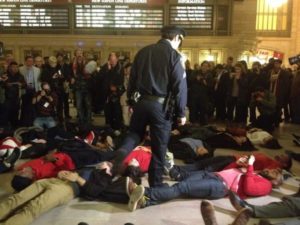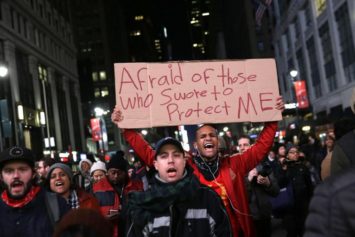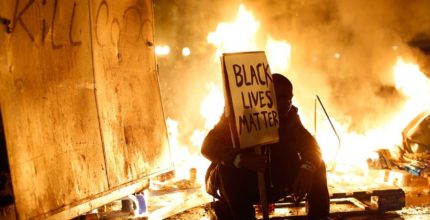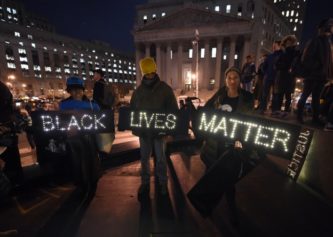Across the nation, from Staten Island to San Francisco, Americans of all colors took to the streets to express their rage and frustration over the grand jury’s decision not to indict New York police officer Daniel Pantaleo in the death of 43-year-old father of six, Eric Garner.
Most of the descriptions of the demonstrations in the media took pains to point out how peaceful they were—to contrast them with the rowdy protests in Ferguson after a St. Louis grand jury last week decided not to indict police officer Darren Wilson in the death of unarmed teenager Michael Brown.
Coming as they did just nine days apart, the two grand jury decisions appear to have awakened many Americans, particularly in the white community, to the idea that something is awry with the nation’s criminal justice system—a system that can’t even produce in the least a criminal trial in a case where a police officer was caught on video killing a man in broad daylight with little provocation and no fear for his life.
In the case of Wilson in Ferguson, there was a great deal of attention directed at Wilson’s statements about how large, scary and threatening Brown was and how much Wilson feared for his life. Many observers felt that Wilson, who is nearly as large as Brown, played up these aspects to give the grand jury the impression that he needed to take drastic action to protect himself—which tends to be an airtight defense for police officers.
But even legal analysts were scratching their heads at the Garner grand jury’s thinking.
“Shame on us for having a criminal justice system that is entirely incapable of prosecuting white police officers in the death of Black men,” attorney Lisa Bloom angrily said on MSNBC.
As the cellphone video showed, at no point did Pantaleo, 29, or any of the other officers appear to be under threat. When Pantaleo, who has been on the force for eight years, appeared before the grand jury on Nov. 21, he reportedly testified that he did not intend to choke Garner, who was being arrested for allegedly selling loose cigarettes.
Pantaleo described the take-down as a maneuver he learned at the police academy. Jurors were able to see it from different angles as three videos of the encounter were shown to them, according to the New York Times. Pantaleo told them that while he was holding onto Garner, he felt fear that they would crash through a plate glass storefront as they fell to the ground, according to his lawyer, Stuart London—thus introducing in the juror’s minds the idea of threat.
But the problem occurred after the take-down, when Garner said repeatedly, “I can’t breathe, I can’t breathe.” Yet Pantaleo didn’t release his arm from around the man’s neck.
While early stories had suggested that Garner died at the hospital of a heart attack and police supporters claimed that his weight was the main reason for his death, the medical examiner’s office was clear, finding “compression of neck (chokehold), compression of chest, and prone positioning during physical restraint by police” killed Garner — though the office did add that Garner’s obesity, diabetes, sleep apnea and asthma were contributing conditions to his death.
Officer Pantaleo released a statement yesterday saying he felt “very bad about the death of Mr. Garner.” The Times said this was the same thing he had told the 23 panelists of the grand jury when he testified before them for two hours.
But in an appearance in Harlem with the Rev. Al Sharpton in Harlem, Esaw Garner, Eric’s wife, said she did not accept the officer’s apology.
“Hell, no,” she said. “The time for remorse for the death of my husband was when he was yelling to breathe.”
“He’s still feeding his kids,” she said of the officer, “and my husband is six feet under and I’m looking for a way to feed my kids now.”
The family earlier this year filed a $75 million lawsuit against the city and the police department.
Mayor Bill de Blasio, speaking on Staten Island, said that it was a “deeply emotional day” for the Garner family and all New Yorkers. De Blasio, whose son Dante is biracial and sports a towering afro, said he had thought of his own son in considering Garner’s fate.
“Today’s outcome is one that many in our city did not want,” Mr. de Blasio said. “Yet New York City owns a proud and powerful tradition of expressing ourselves through nonviolent protest.”
There were protesters in Tompkinsville, Staten Island, at the site where Garner was killed.
“I think the justice system keeps protecting white people,” Robert Copeland, 32, of Brooklyn told Al Jazeera. “I need our American justice system to indict killers, especially if they’re sworn to uphold the law and they instead kill people just like the same people they lock up.”
“This is the most blatant racism I’ve ever seen since I’ve been alive,” Copeland said. “Several Black people have been killed this year and each of their killers got away scot-free. That sends a loud message to Black people.”
While “Hands Up, Don’t Shoot” became the rallying cry after Brown’s death in Ferguson, protesters last night were using “I can’t breathe” as theirs.
While protests popped up in various locations across Manhattan, in Grand Central Terminal there was a silent “die-in” as protestors lay motionless on the ground in the main hall of the train station at 4:30 p.m., at the start of busy rush hour.
“Don’t allow racist cops to join the force,” Soraya SoiFree, 45, of the Bronx told Al Jazeera as she lay on the marble floor. “And rookies need to be better trained.”
“This is a human rights issue,” she added.
In Times Square, protesters by the hundreds chanted, “Help! Help! I can’t breath!”
Meredith Reitman, a 40-year-old white woman from Queens, held a sign that said, “White silence = white consent,” according to the Times.
There was another die-in at Rockefeller Center, where protesters tried to disrupt the annual Christmas tree lighting. But the lights came on anyway.



